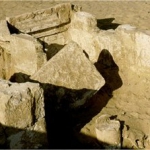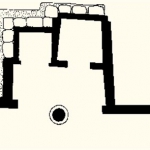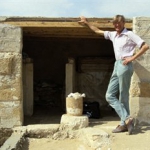General information on Khay’s tomb
Khay was connected with the state treasury as Troop-commander of Traders and Goldwasher. Probably the two titles have to be linked together. This would mean that Khay supervised mining operations in the eastern desert and also commanded the armed escort which accompanied trading missions carrying gold and silver for the treasury. This made him more than just the average artisan, and his tomb clearly shows that he was able to make a decent living out of his activities. His period of office must have covered the second half of the 19th Dynasty, or possibly the beginning of the 20th (c. 1250-1175 B.C.). Khay is sometimes designated in the literature as Khay I to differentiate him from his namesake, whose tomb was found in 2009.

Superstructure of Khay’s tomb
The tomb was constructed on a high bed of rubble which had accumulated between the mudbrick monuments of Horemheb in the south and Ramose in the north. It was excavated in 1986 during the clearing of the area to the west of Tia ‘s pyramid. The superstructure (c. 2.25 x 2.00 m) consists of an antechapel and two rear rooms of different sizes. The east façade is completely open, with a single column in the centre of the doorway. The walls are constructed of limestone orthostats , supported by an exterior wall of irregular blocks and by the south wall of Ramose’s inner courtyard. The masonry is very irregular and perfectly straight angles are a rarity. Although the reliefs, too, are very rough, they contain some scenes of great interest. Apart from the usual scenes of offerings and burial rites, there is a depiction of Khay superintending the activities of the goldwashers, the only one of its kind from Ancient Egypt. Another scene shows the deceased presenting a bowl of gold to the cow-goddess Hathor , who was called the Golden One and was one of the patrons of the mining district. A stela originally from the west wall of the south chapel is now in the Berlin Museum.

Substructure of Khay’s tomb
The shaft of Khay lies immediately in front of the antechapel and is 5.13 m deep. It gives access to five chambers which lie in a semicircle around the shaft and are interconnected(a, b, c, d and e). All of them are irregular in form and only roughly finished. Both the shaft and one of the chambers break through into an adjacent burial-chamber which may have belonged to a relative of the tomb-owner, perhaps his son Piay (Tia B). The shaft and chambers had been robbed in antiquity but even so their clearance was most rewarding. Thus a group of twenty shabtis was found (two in faience, eighteen in wood), inscribed for Piay. There were also parts of a precious openwork mummy cover inscribed for a lady Tabuu. The lavish use of gold leaf on this object suggests that Khay managed to keep for himself some of the material found during his work in the mines.
Most interesting finds from Khay’s tomb
In one of the tomb-chambers of Khay’s subterranean complex the Expedition found fifteen fragments of an intriguing object. Together these wooden elements were all that was left of an openwork mummy cover, a rather rare type of funerary requisite known from a number of parallels from Saqqara and elsewhere. Overlaid in linen and brightly painted gesso, and partly covered in gold leaf, the object must have made a dazzling impression when the coffin of the deceased was opened. The decoration is the usual one for contemporary coffin lids. The body was wrapped in longitudinal and transverse bandages, inscribed with protective spells and with figurative scenes and amuletic designs in between. The presence of gold leaf on the face, hands, and feet surprises in a modest burial such as Khay’s, until one realises that he was used to handle gold during his professional career.
Khay’s family relations
Objects from Khay’s tomb in museum collections
- Berlin, Ägyptisches Museum 7314: stela
Restoration
Following the excavation in 1986, the chapel of Khay was immediately restored. To this effect a modern wall of limestone blocks was erected around the chapel. This helped to support the relief slabs of the chapel, of which several were put back in their original position. Finally, a wooden roof with concrete top layer was laid over the chapel walls. In 2007 some consolidation was done to the platform of rubble in front of the chapel. The front edge of the modern roof was slightly extended forward in order to better protect the entrance to the chapel, which was then closed off by a grilled door.

Bibliography
Martin, G.T. et al., The Tombs of Three Memphite Officials, Ramose, Kha’y and Pabes (London, 2001).
